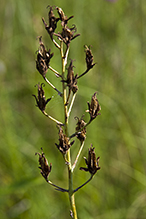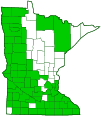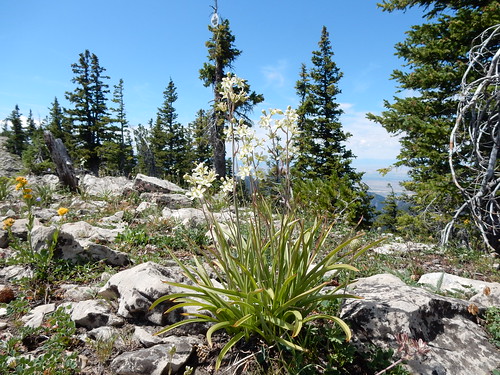mountain death camas
(Anticlea elegans)
Overview • Description • Distribution • Taxonomy
Overview |
|
|||||||
|
||||||||
Description |
||
|
||
Distribution |
||||
|
Sources |
|||
Taxonomy |
|||
| Kingdom | Plantae (Plants) | ||
| Division | Tracheophyta (Vascular Plants) | ||
| Subdivision | Spermatophytina (Seed Plants) | ||
| Class | Liliopsida (Monocots) | ||
Order |
Liliales (lilies, supplejacks, and allies) | ||
Family |
Melanthiaceae (bunchflowers) | ||
| Tribe | Melanthieae | ||
Genus |
Anticlea (death camas) | ||
Mountain death camas was formerly included in the genus Zigadenus. However, that species was broadly defined and lacked very distinctive morphological features. In the nineteenth century (Kunth, 1843) separated it into the genus Anticlea, but this was not widely accepted. Molecular phylogenetic studies in 2001 confirmed its placement with ten other species in the genus Anticlea. USDA PLANTS, Flora of North America, and NatureServe Explorer continue to use the old name Zigadenus elegans. Virtually all other authoritative sources use the new name. |
|||
Subordinate Taxa |
|||
Most sources recognize two subspecies or varieties of mountain death camas. The western subspecies, ssp. elegans, is smaller; the leaves and stems are usually not glaucous; and the inflorescence is usually unbranched, sometimes one- or two-branched. The eastern subspecies, ssp. glaucus, is larger; the leaves and stems are glaucous; and the inflorescence is branched. The ranges of the two subspecies overlap in Minnesota and the Dakotas. There is much intergradation of features throughout the area of overlap. |
|||
Synonyms |
|||
Zigadenus elegans |
|||
Common Names |
|||
death camas mountain death camas mountain deathcamas white camas |
|||
Visitor Photos |
|||||
Share your photo of this plant. |
|||||
| This button not working for you? Simply email us at info@MinnesotaSeasons.com. Attach one or more photos and, if you like, a caption. |
|||||
Greg Watson |
|||||
| I asked Minnesota Wildflowers, https://www.minnesotawildflowers for verification and they agreed it was Mountain Death Camus. They noted that they had never seen it growing on the side of a bluff like that. |  |
||||
 |
|||||
Bill Reynolds |
|||||
| According to Dr Marla Spivak, this a poisonous plant for Honey Bees |  |
||||
MinnesotaSeasons.com Photos |
|||||
 |
 |
||||

Visitor Videos |
|||
Share your video of this plant. |
|||
| This button not working for you? Simply email us at info@MinnesotaSeasons.com. Attach a video, a YouTube link, or a cloud storage link. |
|||
Other Videos |
|||
| Mountain Death Camas - Anticlea elegans Biophilia |
|||
About
Published on Apr 15, 2014 Mountain Deathcamas (Anticlea elegans, formerly Zigadenus elegans) is also known as Elegant Camas or "alkali grass". It is not a grass (though its leaves are grass-like), but belongs to the trillium family, Melanthiaceae. It has white lily-like flowers and two-pronged, greenish-yellow glands on each petal (the shape of which can help in distinguishing it from other members of the genus). It is widely distributed throughout North America and occurs in many habitats. Plants on the western side of the continent tend to be smaller in size than their eastern counterparts, but have more densely clustered flowers. The flower is extremely poisonous. More information at: http://www.untamedscience.com/biodiversity/mountain-death-camas/ |
|||
| Death Camas and Wild Onion LM Publications |
|||
About
Uploaded on Jun 8, 2010 DEATH CAMAS — In the Lily family and is a fatally poisonous plant which can be mistaken for the Wild Onion because of the bulb-like root and the onion-like leaves coming from the base. It is wise to collect these bulb plants only when in bloom for accurate identification. The yellowish flowers grow on stalks crowded together. All parts are toxic. Poisoning Symptoms: Nausea and severe vomiting, diarrhea, mus-cular weakness, a slowing of the pulse and low blood pressure.Treatment: Induce vomiting, followed by a strong laxative. |
|||

Visitor Sightings |
|||||
Report a sighting of this plant. |
|||||
| This button not working for you? Simply email us at info@MinnesotaSeasons.com. Be sure to include a location. |
|||||
| Greg Watson 5/24/2021 |
Location: Stoney Point located within Vetsch Park in La Crescent, MN I asked Minnesota Wildflowers, https://www.minnesotawildflowers for verification and they agreed it was Mountain Death Camus. They noted that they had never seen it growing on the side of a bluff like that. |
||||
Cory Netland |
Location: Grace Marshes WMA (Lund Prairie) Just south of State Highway 40 |
|
|||
| Bill Reynolds 7/11/2014 |
Location: Numedal Township, Pennington Co., Minnesota According to Dr Marla Spivak, this a poisonous plant for Honey Bees |
||||
MinnesotaSeasons.com Sightings |
|||||

|
Created: Last Updated: © MinnesotaSeasons.com. All rights reserved. |




